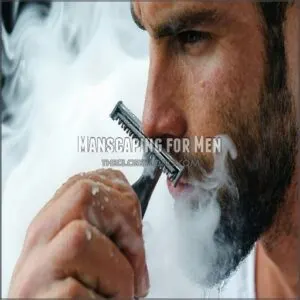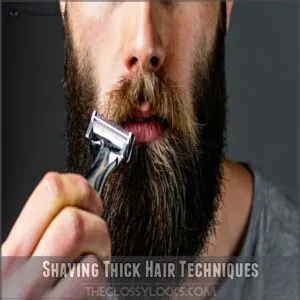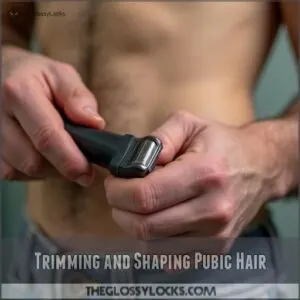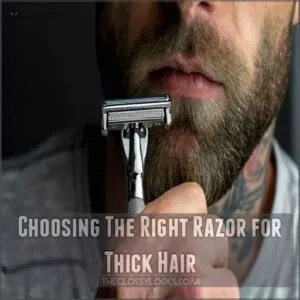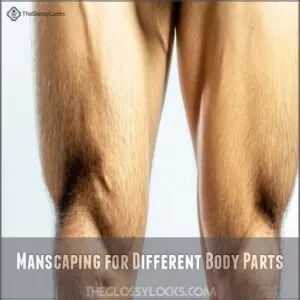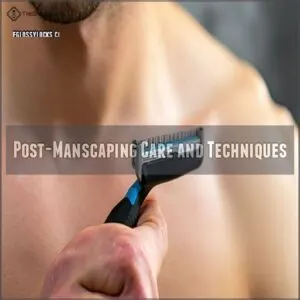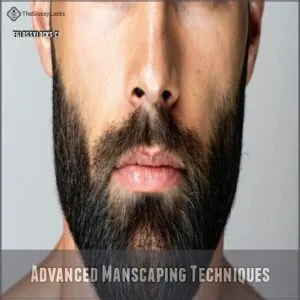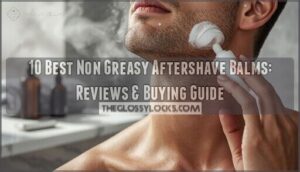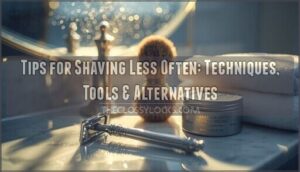This site is supported by our readers. We may earn a commission, at no cost to you, if you purchase through links.
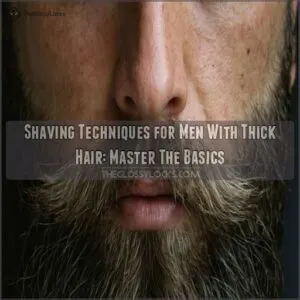
Start by softening your beard with warm water to open pores and reduce tugging.
Use a sharp razor specifically designed for thick hair—avoid the dull ones, they’re trouble.
Trim your hair if it’s long to prevent clogging the razor.
Lather up with a quality shaving cream, then shave with the grain for a start.
If you’re confident, a gentle pass against the grain can smooth things out, but be cautious to avoid irritation.
And remember, there’s more to learn about mastering your mane!
Table Of Contents
- Key Takeaways
- Manscaping for Men
- Shaving Thick Hair Techniques
- Trimming and Shaping Pubic Hair
- Manscaping Sensitive Areas
- Choosing The Right Razor for Thick Hair
- Avoiding Common Shaving Mistakes
- Manscaping for Different Body Parts
- Post-Manscaping Care and Techniques
- Advanced Manscaping Techniques
- Manscaping Safety and Precautions
- Frequently Asked Questions (FAQs)
- How to shave thick hair with a razor?
- How to properly shave coarse hair?
- What is the best razor for thick hair?
- Is it better to shave with or against the grain?
- How to prevent razor bumps after shaving?
- Is shaving cream essential for a smooth shave?
- How often should razors be replaced?
- What pre-shave products enhance shaving experience?
- Can thick hair be laser removed safely?
- Conclusion
Key Takeaways
- Soften your beard with warm water and use a sharp razor designed for thick hair. Trim long hair before shaving to prevent clogging.
- Use a high-quality shaving cream formulated for thick hair and shave with the grain first. Gently shave against the grain if desired, but be cautious to avoid irritation.
- Prep your skin with warm water and exfoliation to prevent irritation. Apply pre-shave oil for extra glide and moisturize afterward.
- Choose a razor with multiple sharp blades and a comfortable grip. Replace blades regularly to maintain sharpness and prevent irritation.
Manscaping for Men
Manscaping lets you take control of your body hair, enhancing your appearance and comfort.
With the right tools and a little practice, you can easily tackle even the thickest hair and embrace a style that suits you.
Importance of Manscaping
Confidence and comfort are two big perks of mastering manscaping.
When you feel groomed and tidy, it’s like wearing a secret style booster under your clothes.
Plus, good manscaping keeps hygiene in check, especially when you’re shaving thick hair close.
Explore the realm of grooming to elevate both your look and feel.
Choosing The Right Tools
Managing thick hair requires using the right tools.
Opt for a sturdy trimmer with adjustable trimming guards to tackle coarse strands efficiently.
Pair it with a high-quality razor blade ideal for dense hair, perhaps an electric razor designed for thick hair.
Don’t forget shaving cream formulated for thick hair—it’s essential for cushioning the razor glide and preventing irritation.
Common Manscaping Styles
With the right tools in hand, you’re ready to explore popular manscaping styles, including those that accommodate patchy beard growth, which can be styled into trendy looks such as The Thin Strap Look.
From trendy cuts to classic styles, there’s something for everyone.
Whether you’re shaping chest hair or going for a complete look, adapting to current body hair trends will keep you in the game, whether you’re shaping chest hair or going for a complete look, adapting to current body hair trends will keep you in the game.
Remember, grooming essentials are your allies in mastering thick hair shaving tips effectively.
Tips for Beginners
Starting with manscaping might feel like steering a ship in a storm without a map.
Grab your manscaping tools, and make sure you trim before you shave—it’s key for tackling thick hair.
Choose a quality razor, one that sings through your follicles, not a dull mutter.
Always use shaving cream to prevent those pesky ingrown hairs.
Shaving Thick Hair Techniques
So, you’ve got thick hair and want a smooth shave? Let’s explore the best techniques to conquer those tough hairs and avoid irritation, making your shaving experience much easier.
Preparing The Skin
Before tackling thick hair, focus on skin preparation.
Warm water and exfoliation remove dead skin, helping to prevent irritation.
Think of it as laying a smooth road for your razor.
Apply pre-shave oil for extra glide.
Moisturizing afterward keeps skin calm.
These steps make shaving thick hair more of a breeze, ensuring you’re all set for a smoother experience.
Trimming Before Shaving
Imagine this: you’re preparing for shaving, and it’s like gardening before the big cut.
Grab those trimming tools, set your hair length right—keeping it short can help the razor glide smoothly.
Proper skin prep with a splash of warm water or splash of humor, like "Shaving’s not so hair-raising!" helps keep things safe.
Shaving cream ensures a slick path.
Using The Right Razor
Ever wondered how the right razor makes a difference? Choosing a razor for thick hair requires attention to detail:
- Blade Count: More blades offer a closer shave.
- Sharpness: Keeps it smooth and irritation-free.
- Handle Grip: Provides control and precision.
- Maintenance Routine: Keeps your razor efficient.
Opt for sharp blades and a comfy grip for freedom in shaving!
Shaving Against The Grain
Although tempting, shaving against the grain for a closer shave can stir up trouble.
Don’t let the lure of smooth skin trick you into unwanted razor burn and bumps.
Thick hair demands respect, so try going with the flow—literally.
Stick to the hair growth direction to avoid skin irritation and dreaded ingrown hairs.
Master this, and you’ll reap smoother rewards.
Avoiding Irritation and Ingrown Hairs
To keep razor burns and ingrown hairs at bay, begin with proper skin prep by exfoliating.
Use a good shaving cream to soften thick hair and choose the right razor.
Shave patiently, avoid too much pressure, and follow up with post-shave care to soothe sensitive skin.
These shaving tips help create a smooth result without irritation.
Trimming and Shaping Pubic Hair
Got thick hair downstairs that’s getting a bit wild?
Don’t worry—trimming and shaping your pubic hair can be simple and painless with the right tools and techniques,
leaving you feeling fresh and confident.
Trimming Techniques for Pubic Hair
So, you’ve prepped your skin and tackled the initial trim. Now, let’s focus on those pubic hairs. Getting a clean, even trim is key to avoiding razor burn.
Remember these trimming tips:
- Use sharp, clean pubic hair trimming tools.
- Trim against the direction of hair growth for a closer cut, but be gentle.
- Always rinse your trimmer or razor to prevent clogging.
Shaping and Styling Options
Three shapes you might fancy when styling pubic hair include fades, triangles, or landing strips.
Experiment with grooming trends and consider these fun, trusty styles:
| Style | Description | Difficulty Level |
|---|---|---|
| Fade | Gradually shortens in the center | Moderate |
| Triangle | Sharp corners, classic look | Easy |
| Landing Strip | Thin, straight line | Easy |
| Heart | Playful and romantic shape | Advanced |
| Natural Trim | Simple, neat look | Easy |
This table gives you patterns and practical manscaping tips.
Avoiding Ingrown Hairs and Irritation
Shaving thick hair requires precision to dodge ingrown hairs and irritation.
Make the most of these tips:
- Exfoliate before you shave; it unclogs pores and loosens hairs.
- Use a proper technique by gliding with hair growth.
- Pick a razor wisely—sharpness matters.
- Finish with moisturizing aftershave to soothe the skin.
Tips for Trimming The Perineum and Backside
When trimming the perineum and backside, safety and comfort are key.
Use electric grooming clippers to painlessly manage sensitive skin.
Make sure hygiene by sanitizing tools before and after use.
Maneuver carefully with a mirror to avoid mishaps.
This approach keeps your manscaping routine efficient and worry-free, making pubic hair removal less intimidating and more of a smooth sail.
Manscaping Sensitive Areas
When you’re manscaping sensitive areas, like the balls and shaft, it’s important to use the right techniques to avoid accidents.
A steady hand and the right tools can make all the difference between a smooth finish and a regrettable mishap.
Shaving The Balls and Shaft
Now that you’ve shaped up your pubic hair, it’s time to conquer the delicate task of shaving the balls and shaft.
Reach for a sharp razor and a good shaving cream to protect sensitive skin.
Gently shave with the grain, applying no pressure. It reduces the risk of pain and irritation.
Remember, post-shave care is key for smooth, comfortable results.
Trimming The Perineum and Backside
Embrace precision when trimming the perineum and backside—comfort and safety go hand in hand.
- Trim safely: Use a body groomer with a guard.
- Pain management: Keep skin taut, reducing nicks.
- Avoid ingrown hairs: Trim, don’t shave.
- Maintain hygiene: Clean and sanitize tools.
- Pubic hair grooming: Work slowly, checking progress often.
Manscape with finesse and confidence!
Using The Right Tools and Techniques
Tackling those sensitive areas requires the right gear. Choose a trimmer with adjustable guard settings for precise control, ensuring you don’t nick yourself.
Prep your skin with warm water and shaving cream for thick hair—it makes a huge difference.
When dealing with especially sensitive areas, consider using a razor specifically designed for men’s razors for sensitive skin. Use short, gentle strokes; shaving against the grain is a recipe for disaster.
Remember, a sharp razor blade is your best friend; dull blades cause irritation.
Choosing The Right Razor for Thick Hair
When you’re dealing with thick hair, choosing the right razor can feel like picking the perfect sidekick for a smooth shave.
You need a razor that’s up to the task, with features that tackle tough hair without turning your morning routine into a tug-of-war.
Types of Razors for Thick Hair
For manscaping sensitive areas, understanding razor types is key.
When managing thick hair, consider whether you prefer disposable or reusable options.
Multi-blade razors can offer a smoother shave, but electric shavers are often a go-to for quickness without nicks.
Testing what’s best for shaving your thick hair and coordinating with a suitable routine and shaving cream is essential.
Features to Look for in a Razor
When picking the best razor for thick hair, always consider the blade count—more blades offer a smoother shave.
Check for a good lubrication strip to minimize irritation.
A well-designed handle grip can make all the difference, providing control and precision.
Razor type matters too, whether it’s straight, safety, or electric.
Don’t overlook blade sharpness for effective shaving.
Brands and Models for Thick Hair
Finding the best razor for thick hair can feel like searching for a needle in a haystack.
Options like the Gillette Fusion5 ProGlide provide smoother shaves with ease.
Go electric with the Panasonic Arc5 if you want a high-tech solution.
Use shaving cream for thick hair to reduce friction and say goodbye to irritation.
Tips for Using a Razor With Thick Hair
Got your razor brand locked down? Great. Now, thick hair requires a touch more finesse.
Consider using a razor specifically designed for thick hair, such as those found on websites for the best razor for thick hair.
Prep with a good shaving cream designed for thick hair to soften those stubborn strands.
Glide carefully with an electric razor to prevent razor burn.
Rinse often and finish with a soothing aftercare lotion.
This routine helps your shave stay smooth and irritation-free.
Avoiding Common Shaving Mistakes
When you’re shaving thick hair, skipping essential steps can lead to irritation, cuts, and regret.
Let’s tackle common mistakes like using dull razors or skipping shaving cream, so your skin stays smooth and nick-free.
Using Dull Razors
So, you’ve picked the perfect razor for your thick hair—great! Now, don’t let a dull blade ruin your smooth finish.
A dull razor is a recipe for disaster: razor burn, skin irritation, and those pesky ingrown hairs are more likely.
For shaving efficiency, replace your blades regularly.
Think of it as an investment in your skin’s happiness. Trust me, your skin will thank you.
Sharp blades mean a closer shave, preventing irritation for a better thick hair shaving routine.
Happy shaving!
Not Trimming Before Shaving
Skipping the trim before shaving is like heading into a dense forest without a path; you’re bound to encounter resistance.
Trimming first:
- Reduces hair pulling and discomfort.
- Prevents razor burn and skin irritation by creating a smoother surface.
- Helps avoid ingrown hairs by minimizing razor drag.
This step is key for a hassle-free thick hair shaving routine.
Not Using Shaving Cream or Gel
Using shaving cream or gel is like putting air in your tires before a road trip—it’s essential for a smooth ride.
Without it, you’re courting skin irritation and razor burn.
With thick hair shaving, dry shaving isn’t an option.
The benefits of a good shaving cream or gel include reducing friction, minimizing irritation, and ensuring comfort.
Not Rinsing The Razor
Neglecting razor hygiene is like letting a cluttered closet hold you back.
When blades are clogged, they become dull razors that irritate your skin and invite bacterial growth.
Regularly cleaning and disinfecting with methods like how to clean with alcohol will help maintain your razor’s sharpness and performance.
Rinse thoroughly after every few strokes to avoid razor burn and irritation, especially with thick hair.
Make cleaning a habit, and you’ll glide smoothly into a better shave, free of woes.
Manscaping for Different Body Parts
Manscaping different body parts might seem like juggling flaming torches, but it doesn’t have to be tricky.
With the right tools and techniques, you can easily tame everything from brows to toes, making sure each area gets the attention it needs.
Eyebrows and Ears
How do you tackle those unruly hairs? Eyebrow shaping and ear hair removal can be a breeze with the right grooming tools.
Follow these simple steps:
- Eyebrows: Use tweezers for precise shaping, plucking stray hairs.
- Ears: Trim visible hairs with small clippers.
- Grooming Tips: Regular maintenance keeps your look in check, boosting confidence!
Nose and Chest
Next up: your nose and chest. Trimming nose hair is a breeze with small scissors or a specialized nose hair trimmer.
For chest hair grooming, you’ve got options, and you can explore different clippers specifically designed for chest hair clippers.
| Style | Tools | Description |
|---|---|---|
| Short & Neat | Trimmer, clippers | A clean, well-groomed look. |
| Natural Look | Trimmer with longer guard settings | Let your chest hair shine through, just a bit neater. |
| Bare Chest | Razor, shaving cream, aftershave | A smooth, hairless chest requires careful technique, avoid irritation. |
Remember, less is more, especially with sensitive areas!
Back and Shoulders
Just as you tackle nose and chest hair, think about how back and shoulder hair removal adds to the confidence boost.
A smooth back is within reach:
- Use a trimmer with an extended handle.
- Apply shaving cream generously for glide.
- Follow hair growth patterns for fewer ingrown hairs.
- Opt for a sharp razor to avoid razor burn.
- Get a buddy to help with tricky spots.
Groin and Legs
Switching gears from the shoulders, let’s talk about the groin and legs.
For the groin, using appropriate tools is key—opt for a trimmer or razor designed for sensitive areas to prevent ingrown hairs.
When tackling legs, a sharp razor and shaving cream offer smooth results.
Remember, relaxation and steady hands will keep your grooming game strong and stress-free.
Arms and Feet
Manscaping your arms and feet can be tricky, but here’s how to tackle it competently:
- Prep Hair: Trim with clippers for uniform length.
- Lather Up: Using a quality shaving cream prevents razor burn.
- Shave Carefully: Glide the razor gently to avoid nicks.
- Soothe Skin: Apply moisturizer as a post-shave treatment for a lasting smoothness.
Post-Manscaping Care and Techniques
After manscaping, it’s important to pamper your skin with aftershave and moisturizer to keep irritation at bay.
Don’t skip treatments for ingrown hairs and exfoliate regularly to maintain smooth, stubble-free skin that won’t scare off any potential admirers!
Applying Aftershave and Moisturizer
You’ve tackled the task of grooming different body parts; now it’s time to soothe and protect your skin.
Applying aftershave lotion helps close pores and refresh your skin, while a good moisturizer prevents dryness, offering hydration that battles irritation.
Opt for products with soothing ingredients like aloe vera. Your skin will thank you, keeping it calm and comfortable after shaving thick hair.
Treating Ingrown Hairs and Irritation
Dealing with pesky ingrown hairs and irritation? Here’s a game plan:
- Apply a warm compress to soften skin and ease ingrown hairs. Ingrown hairs can last anywhere from 1-2 weeks, but knowing the healing process can help you manage them more effectively.
- Use an aftershave balm to soothe razor burn.
- Switch your razor regularly to prevent dullness and irritation.
- Choose shaving cream wisely—opt for those designed for thick hair to minimize friction.
Exfoliating and Cleansing The Skin
Let’s get your skin squeaky clean! After shaving thick hair, exfoliating is key. It helps prevent ingrown hairs and keeps your skin smooth. Here’s a simple routine:
| Step | Product Recommendation | Action | Frequency | Benefits |
|---|---|---|---|---|
| Cleanse | Gentle cleanser | Wash with warm water; rinse thoroughly | Daily | Removes dirt and oil |
| Exfoliate | Skin scrubs, Exfoliating tools | Gently scrub in circular motions; rinse well | 2-3 times/week | Removes dead skin cells |
| Moisturize | Alcohol-free lotion or balm | Apply evenly | Daily | Soothes and hydrates |
| Treat Ingrowns | Ingrown hair serum or treatment | Apply to affected areas | As needed | Prevents and treats ingrown hairs |
| Protect | Sunscreen (SPF 30 or higher) | Apply after cleansing and moisturizing | Daily | Shields against sun damage |
Following this cleansing routine will help you keep your skin happy and healthy.
Preventing Stubble and Regrowth
For managing thick hair, knowing the right shaving frequency can be your secret weapon against stubble.
Timing your shaves with hair growth cycles helps maintain smoothness.
Exfoliation methods clear away dead skin, while post-shave care with hydrating products prevents irritation.
Experiment with alternatives like laser treatments for longer-lasting results.
Remember, the right products make all the difference.
Advanced Manscaping Techniques
Level up your grooming game by mastering advanced manscaping techniques like fading and blending to achieve a natural look.
Use trimmers and razors smartly to shape and maintain your style with ease, even if your hair is as stubborn as a mule.
Fading and Blending Hair
Mastering hair blending techniques involves using trimmers and clippers for effective fading styles.
Start with blending tools set at varying lengths to seamlessly move from thick areas to shorter sections.
Fade tips include keeping a steady hand and moving the trimmer upward in gentle, sweeping strokes.
This approach helps you control the outcome, achieving a smooth, professional blend without hassle.
Creating a Natural Look
Achieving a natural look isn’t about removing every hair.
Instead, focus on blending and subtle changes.
Here’s how:
- Hairlines: Use gradual fades for a seamless finish.
- Body Hair: Trim to balance thickness naturally.
- Maintenance: Regular touch-ups prevent razor burn on thick hair.
Remember, nature doesn’t rush perfection, so take your time for best results.
Using Trimmers and Razors
Ready to wrangle that mane? Use trimmers and razors for precision and flexibility.
Adjust trimmer settings for length variety, and choose blades designed for thick hair.
Pair with quality shaving creams to glide smoothly.
Here’s a quick guide:
| Feature | Trimmers | Razors |
|---|---|---|
| Control | Adjustable settings | Fixed blade lengths |
| Flexibility | Multiple styles | Close, clean shave |
| Maintenance | Minimal upkeep | Frequent replacement |
Shave smartly, prevent razor burn!
Tips for Advanced Manscaping
For advanced manscaping, blend your skills with fading techniques and precise shaping styles.
Selecting the right tools, especially an electric razor for thick hair, is key.
To tackle thick hair, consider a specialized manscaping trimmer for thick hair for a closer, more comfortable shave.
Consider skin care to prevent razor burn and irritation.
If you’re feeling adventurous, try different styles.
Sometimes, getting professional help can save the day, giving you that polished, controlled look.
Manscaping Safety and Precautions
So, you’ve mastered the art of blending and fading—congrats! Now, let’s talk safety. Manscaping can be a bit of a wild ride, so let’s keep things smooth.
Always sanitize your tools before and after use to avoid infection.
A little pre-shave prep goes a long way; soften your thick hair with warm water and a good shaving cream to minimize skin irritation – following a consistent shaving routine can also help reduce razor burn, as explained in these shaving tips for a clean shave shaving tips for a clean shave.
Watch out for those ingrown hairs—they’re a pain! Gently exfoliate afterward. If you’re prone to razor burn, use a sharp razor and shave with the grain.
Pay attention to your skin; if you notice any allergic reactions, stop immediately and see a doctor.
Remember, patience is key; rushing can lead to cuts and nicks.
Frequently Asked Questions (FAQs)
How to shave thick hair with a razor?
To shave thick hair smoothly, soak in warm water to soften it, then apply shaving cream.
Use a sharp razor, shaving in the hair’s growth direction.
Glide gently to avoid irritation.
Maintain your razor’s cleanliness for best results.
How to properly shave coarse hair?
Ever tried shaving coarse hair only to feel like you’re tackling a wild mane?
Start by softening hairs with warm water and shaving cream.
Then use a sharp razor, moving with the grain for smoother results.
What is the best razor for thick hair?
For thick hair, try the Gillette Fusion ProGlide razor.
It’s designed with sharp blades and a lubricating strip to reduce friction, offering a smooth shave.
Its precision trimmer helps tackle hard-to-reach areas effortlessly.
Is it better to shave with or against the grain?
Shaving against the grain gives a closer shave, but it can irritate your skin.
Shaving with the grain is gentler, leading to less irritation.
Experiment to find what works best for you.
How to prevent razor bumps after shaving?
Razor bumps affect nearly 60% of men, but you can avoid them.
Shaving in the direction of hair growth, and applying a soothing, alcohol-free moisturizer post-shave can help.
Use a sharp blade for a smooth, bump-free finish.
Is shaving cream essential for a smooth shave?
Using shaving cream can be essential for a smooth shave.
It softens hair and provides a protective layer, reducing friction and irritation.
Without it, you risk nicks, cuts, and skin irritation, making shaving more uncomfortable.
How often should razors be replaced?
Think of your razor blade like a car tire—it should be swapped out regularly to keep running smoothly.
Replace your razor every 5-7 shaves to avoid nicks, irritation, and overheating, ensuring a consistently close shave.
What pre-shave products enhance shaving experience?
Pre-shave products like oils or creams soften thick hair, making shaving smoother and more comfortable.
They create a slick surface, reducing razor drag and minimizing irritation, so you can glide through your shaving routine like a pro.
Can thick hair be laser removed safely?
Yes, thick hair can be safely removed using laser treatments.
It’s a reliable solution if you’re looking for long-term results, but multiple sessions are essential.
Make sure a qualified professional handles your treatments for safety.
Conclusion
Jumping into the groove of shaving thick hair is like tuning a radio to your favorite station.
Embrace the art of proper preparation, select the right tools, and note the essentials of shaving techniques for men with thick hair.
With consistent care and employing a sharp razor, you’ll minimize irritation and harness a smooth shave every time.
Remember, practice makes perfect, and with these tips, you’re well on your way to mastering your mane confidently.

